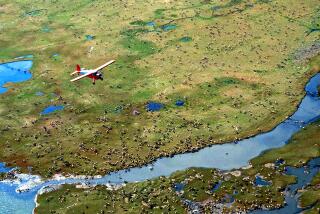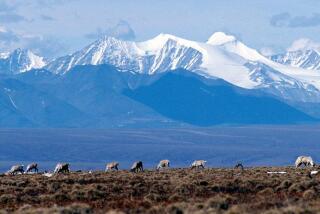Drilling in Arctic Wildlife Refuge
- Share via
I applaud Interior Secretary Bruce Babbitt for taking on Big Oil by opposing its bid to trash the Arctic National Wildlife Refuge in Alaska for a maximum of six months’ oil supply at current national consumption levels (Commentary, Aug. 21).
Big Oil doesn’t want you to know this, but America’s best energy resource by far is conservation. If the United States were as energy efficient as Western Europe, dependence on unstable foreign sources of oil would plummet, as would the amount of taxpayer money spent on murderous military forays initiated to enforce price stability. Though unglamorous, simple and technologically feasible adjustments such as increasing automobile fuel mileage, augmenting home insulation and increasing factory efficiency can “create” much more energy than further tearing apart the Earth’s crust and destroying a pristine refuge.
CHRIS FORD
Santa Monica
*
* Babbitt’s excellent column on saving “a priceless Arctic treasure” left out one key reason to do so. Not only is the Arctic National Wildlife Refuge an incomparable wilderness worthy of the nickname “America’s Serengeti,” and a highly unlikely source of oil that will do nothing to reduce the deficit or the nation’s dependence on foreign oil, it is also critical to the survival of an ancient indigenous culture.
For a thousand generations, the culture and way of life of the Gwich’in Athabascan Indians of Canada and Alaska have been inextricably intertwined with the 150,000 caribou that bear and nurse their young each year on the Arctic Refuge Coastal Plain--the area in dispute. Caribou provide the Gwich’in, who call themselves caribou people, far more than food. Gwich’in lore, songs, stories and dance are about caribou and their winter boots and tools are derived from them. If anything happens to the herd--if oil activities reduce their numbers by 40% or alter their migration patterns as scientists predict--the Gwich’in people and culture will suffer the consequences. There may simply not be enough caribou to feed them or the herd may not migrate near their villages, putting them out of range of the hunters.
Haven’t enough traditional cultures suffered for the sake of the almighty buck? Future generations will condemn us if we allow the destruction of the Arctic National Wildlife Refuge--our last great wilderness. But future generations of Gwich’in may not even be around to do that.
SUSAN ALEXANDER, Vice President
Environmental Communications
Public Media Center
San Francisco
More to Read
Sign up for Essential California
The most important California stories and recommendations in your inbox every morning.
You may occasionally receive promotional content from the Los Angeles Times.










